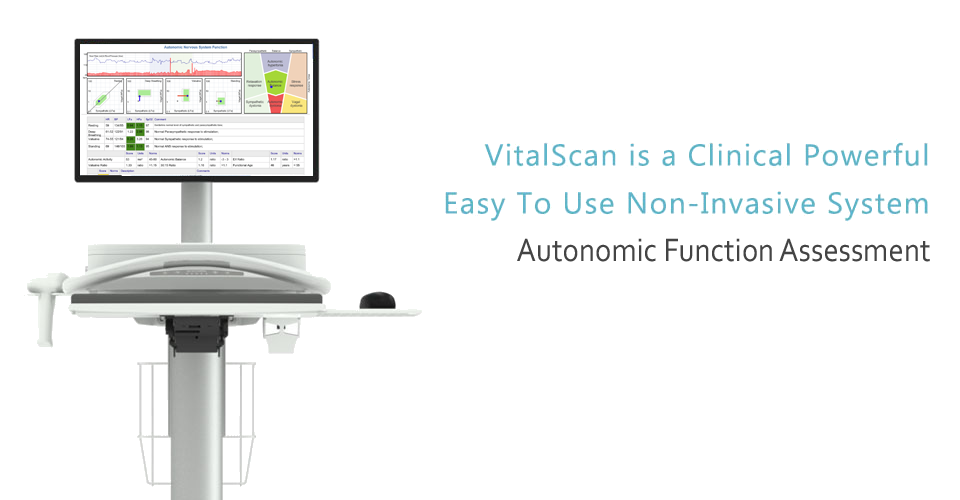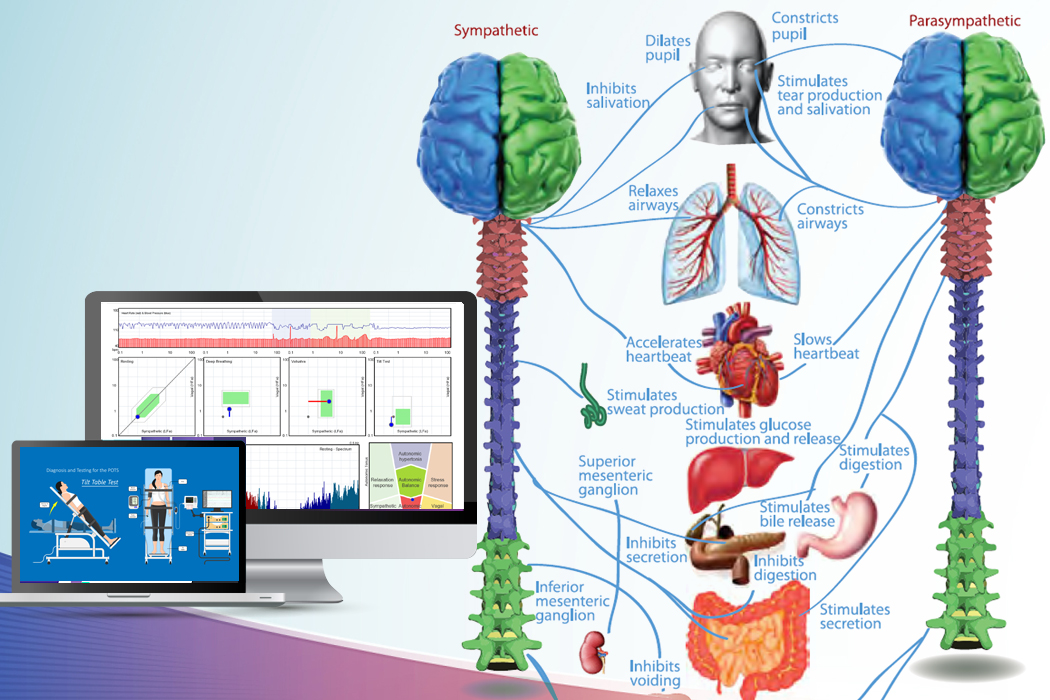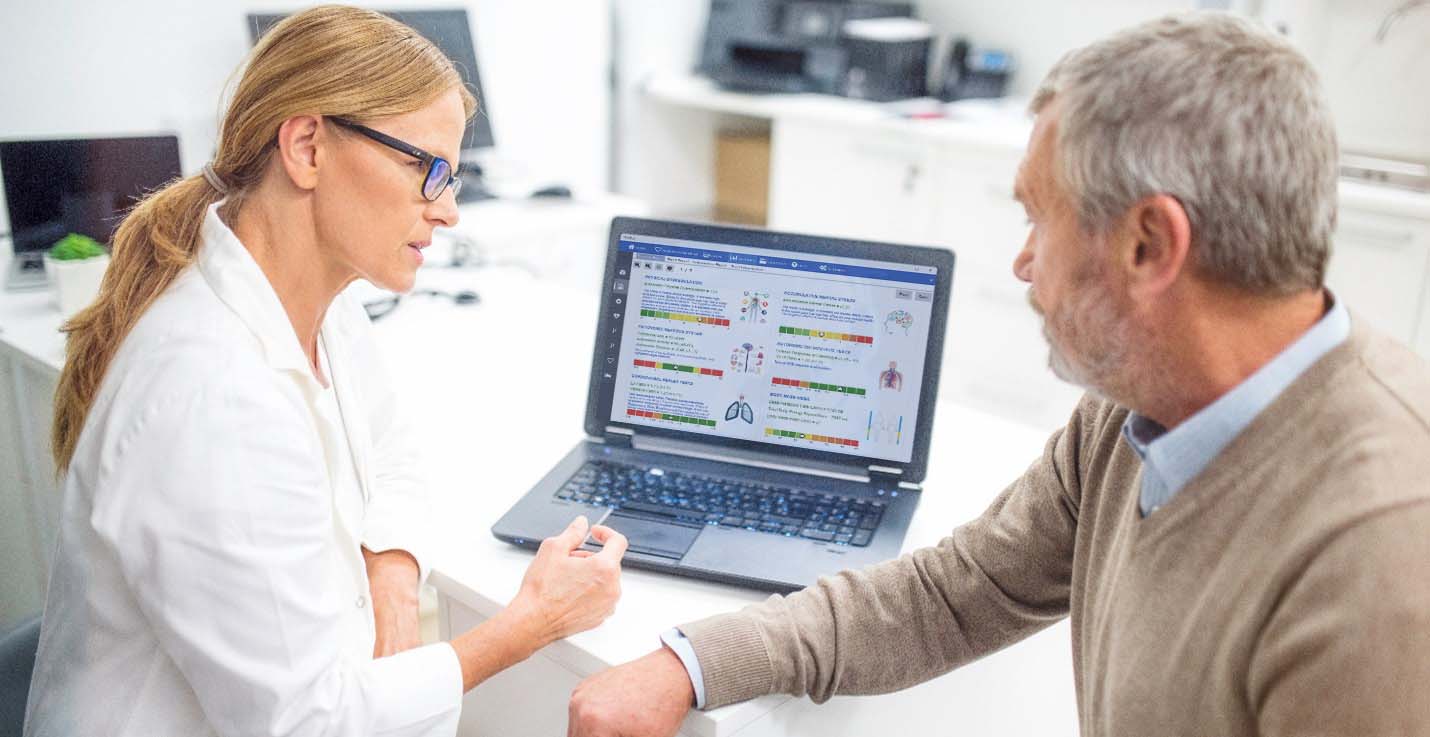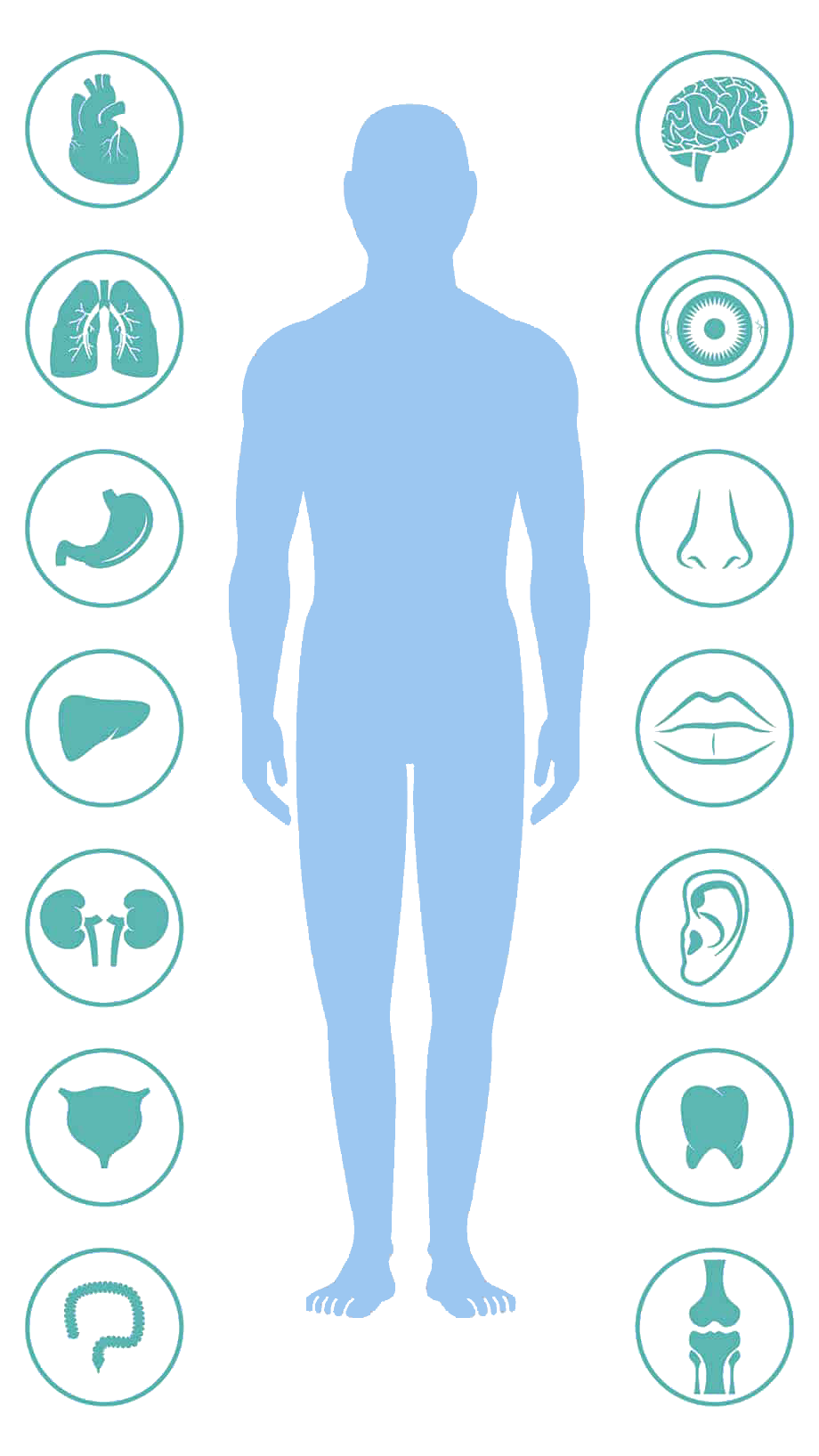- +1 800 433 4609
- |
- Request Info
Autonomic Function Assessments
Benefits all Medical Branches Including:
Primary Care, Cardiology, Pulmonology, Endocrinology, Neurology, Pain Management
VitalScan ANS+
Autonomic Nervous System (ANS) Testing provides comprehensive, fully automated autonomic testing valuable equipment for physicians to gauge their patient's health and uncover hidden diseases. The system is US FDA 510(k) cleared.
Testing the autonomic nervous system can identify the following clinical autonomic disorders:
|
|

Physician Benefits
VitalScan ANS+ is a valuable tool in diagnosing hidden illnesses. Medical practitioners can quickly and easily test patients and receive immediate comprehensive interpretive reports.
VitalScan ANS+ has 39 standardized tests and can customize testing protocols.
Why Test ANS?
- "According to Published Studies "Cardiovascular autonomic neuropathy occurs in about 17% of patients with type 1 diabetes and 22% of those with type 2"
- "Of patients with symptomatic autonomic dysfunction, 25% to 50% die within 1 to 5 years of diagnosis."
- "A patient's history and physical examination are ineffective for early detection of CAN, and therefore noninvasive tests that have demonstrated efficacy are required".
- "Screening for Autonomic Neuropathy should be instituted at Diagnosis of Type 2 Diabetes and 5 years after the diagnosis of type 1 Diabetes - 2005 ADA Standard of Diabetes Care"
- "Although it can cause severe cardiovascular problems and sudden death, surveys show that only 2% of people with diabetes are tested for cardiovascular autonomic neuropathy (CAN)".
Features and Benefits
- Easily adaptable towards general and specific requirements of almost all medical branches.
- Presents a quick and reliable supplementary assessment of primary health risk factors. Assesses the balance between the sympathetic and parasympathetic branches of the autonomic nervous system.
- Reliably discovers ventricular and supraventricular extrasystoles.
- Assesses autonomic physical dysregulation, accumulated physical and mental stress.
- Assesses physical training needs based upon an individual's cardiovascular fitness levels.
- Reveals development of possible health risks.
- Provides early indications of health risks for quick detection and prevention of illness, disease, and progressive stress conditions before onset and development.
- Efficiently screen mass population to detect potential risks and reserve costly, full medical checkups for only those exhibiting health threats.

Significant Clinical Applications
VitalScan ANS+ is a diagnostic tool to evaluate symptoms of vasomotor instability for any of the following:
- Diagnose the presence of autonomic neuropathy in a patient with symptoms suggesting a progressive autonomic neuropathy, including Diabetic neuropathy, Amyloid neuropathy, Sjogren's syndrome, Idiopathic neuropathy, Pure autonomic failure, and Multiple system dystrophy.
- Evaluate the severity and distribution of a diagnosed progressive autonomic neuropathy
- Differentiate the diagnosis between certain variants of syncope from other causes of loss of consciousness
- Evaluate inadequate response to beta blockade in vasodepressor syncope
- Differentiate the cause of postural tachycardia syndrome
- Evaluate change in type, distribution or severity of autonomic deficits in patients with autonomic failure
- Evaluate the response to treatment in patients with autonomic failure
- Diagnose axonal neuropathy or suspected autonomic neuropathy in the symptomatic patient
- Evaluate and diagnose sympathetically maintained pain, as in reflex sympathetic dystrophy or causalgia
- Evaluate and treat patients with recurrent unexplained syncope to demonstrate autonomic failure
VitalScan ANS+ assessments provide supplemental monitoring and optimized detection of cardiovascular, neurological, and metabolic conditions associated with many adverse health events. The VitalScan ANS+ product range offers physicians and health professionals convenient, cost-effective solutions for clinical testing and optimized patient assessment.
Applications include the following:
Applications include the following:
|
|
How It Helps Patients:
- Evaluation of current health situation - symptoms, medications and therapy reactions
- Assessment of possible adequacy of the recovery process
- Initiation of Physician's focus to treat the onset of chronic situations or severity of the diseases
- Evaluation of the prognosis and treatment outcomes
- Identification of abnormalities in cardiovascular, cerebrovascular system and overall health assessment
- Blood circulatory status - age of blood vessels based on arterial elasticity, peripheral circulatory rate, organic/functional abnormality of the blood vessels
- Prediction and progression of Arteriosclerosis, Obesity, Hypertension, Hyperlipidemia and Diabetes
- Useful as a health barometer
How It Helps Clinicians:
- Monitoring current health of the individual patient closely
- Verifying the efficacy of current treatment protocol and intervention
- Examining patients for Cardiac Autonomic Neuropathy (CAN) and Diabetes Autonomic Neuropathy (DAN)
- Measuring the Metabolic Syndrome, Hypertension, Heart Failure
- Predicting burn-out syndrome, anxiety, depression, psychological conditions
- Exploring Asthma, COPD, Palpitations, Pain management, Sleep apnea
- Optimization of treatment for each individual patient
- Immediate reports - qualitative, quantitative and graphic analysis and results of ANS balance, cardiovascular, stress, fitness and overall health assessment
- Comparisons with a patient case history and necessary procedural actions
- Efficient patient-centered multiple symptoms treatment management
What is Autonomic Nervous System (ANS)
The Autonomic nervous system (ANS) regulates physiological processes, such as blood pressure, heart rate, body temperature, digestion, metabolism, fluid, electrolyte balance, sweating, urination, defecation, and sexual response. Regulation occurs without conscious control, i.e., autonomously. The ANS has two major divisions: the sympathetic and parasympathetic systems. Many organs are controlled primarily by the sympathetic or parasympathetic system, although they may receive input from both; occasionally, functions are reciprocal (e.g., sympathetic intake increases heart rate; parasympathetic decreases it).
The sympathetic nervous system is catabolic and activates fight-or-flight responses. Thus, sympathetic output increases heart rate and contractility, bronchodilation, hepatic glycogenolysis and glucose release, BMR (basal metabolism rate), and muscular strength; it also causes sweaty palms. In addition, more minor immediately-life-preserving functions (e.g., digestion, renal filtration) are decreased.
The parasympathetic nervous system is anabolic; it conserves and restores. As a result, gastrointestinal secretions and motility (including evacuation) are stimulated, slowed heart rate, and blood pressure decreases.
Disorders of the ANS can affect any system of the body; they can originate in the peripheral or central nervous system and may be primary or secondary to other disorders. Symptoms suggesting autonomic dysfunction include orthostatic hypotension, heat intolerance, nausea, constipation, urinary retention or incontinence, nocturia, impotence, and dry mucous membranes. If a patient has symptoms suggesting autonomic dysfunction, cardiovagal, adrenergic, and sudomotor tests are usually done to help determine the severity and distribution of the dysfunction.
Autonomic Regulation is the body's ability to maintain homeostasis (stability and balance) during internal and external stimuli. Autonomic Regulation is always functioning, and we are often unaware of the crucial tasks. When the nerves that control Autonomic Regulation are damaged, Autonomic Dysfunction can develop. Autonomic Dysfunction can be temporary or chronic. Diabetes and Parkinson's disease are two examples of chronic conditions that can lead to Autonomic Dysfunction. VitalScan ANS+ tests Autonomic Regulation through a combination of Heart Rate Variability (HRV) Assessment and Cardiac Autonomic Reflex Tests (CARTs).
Cardiovagal innervation testing evaluates heart rate response to deep breathing and the Valsalva maneuver via electrocardiogram rhythm strip. If the ANS is intact, heart rate varies with these maneuvers; the Valsalva ratio of longest to shortest HR should be 1.4 or greater.
Vasomotor adrenergic innervation testing evaluates the response of beat-to-beat blood pressure to the head-up tilt and Valsalva maneuver. The head-up tilt shifts blood to dependent parts, causing reflex responses. The Valsalva maneuver increases intrathoracic pressure and reduces venous return, causing blood pressure changes and reflex vasoconstriction. In both tests, the pattern of responses is an index of adrenergic function.
Cardiac Autonomic Testing Benefits
Cardiac Autonomic Testing measures neuro-cardiac function, reflecting heart-brain interactions and autonomic nervous system dynamics. The autonomic nervous system is involved in the function of virtually every organ system, and clinical manifestations of autonomic dysfunction are involved in just about every disease. As a result, ANS analysis is used as a screening and monitoring tool in many disease processes.
Autonomic Function Assessment has acquired exceptional popularity over the last few years. Nowadays, the mainstream medical associations worldwide accept ANS studies as one of the best predictors of specific and non-specific health risks. In addition, scientific and clinical studies have established their usefulness in almost all branches of medicine.
VitalScan ANS+ delivers laboratory analyses to the physician's office, enabling professionals to assess patient health conveniently and reliably.
Applications include:
- Verifying the effectiveness of treatment and intervention
- Monitoring overall patient health
- Screening the general population
- Identifying various health issues such as heart palpitations, pain management, sleep apnea, anxiety, stress, psychological disorders, asthma, and neurological conditions
- Examining for Cardiac Autonomic Neuropathy (CAN) and Diabetes Autonomic Neuropathy (DAN)
- Measuring the Sympathetic Nervous System's predominance in cases such as Metabolic Syndrome, Hypertension or Heart Failure
- Screening for unfavorable in the absence of clinically apparent health situations
How Is the Test Performed?
The test involves four phases, each designed to determine a particular aspect of the patient's Autonomic Nervous System function.
-
Resting Phase:
Heart Rate Variability (HRV) analysis combined with beat-to-beat blood pressure is measured to obtain a baseline of how the autonomic system is functioning during the resting phase. -
Deep (Metronomic) Breathing Test:
Heart Rate Variability combined with beat-to-beat blood pressure is measured and monitored during Deep Breathing. Additional comparisons are made to determine the changes during Deep Breathing from the baseline and the baroreflex response. -
Valsalva Test:
Heart Rate Variability combined with beat-to-beat blood pressure is measured during Valsalva Maneuver. Additional monitoring and comparisons are obtained to determine the change from the baseline compared to the Valsalva maneuver. -
Standing or Tilt Test:
Heart Rate Variability coupled with beat-to-beat blood pressure is monitored and measured during Standing/Tilt, and changes are compared with the baseline.
The data obtained from the ANS test evaluates the Parasympathetic (rest and digest) and the Sympathetic (fight, flight response) system, and entire ANS system balance.
Obtaining objective data on the ANS parasympathetic and sympathetic components can pinpoint health risks such as sudden death, silent heart attacks, syncope, hypertension, and other hidden diseases. Beat-to-beat blood pressure under various conditions can test adrenergic functions for conditions like orthostatic hypotension (OH). OH is widely known to be a consequence of chronic diabetes frequently found amongst the elderly population. Since many OH symptoms can be difficult to trace - impaired concentration and fatigue. ANS testing can fill this void and bring these problems to light sooner.
The VitalScan ANS+ system is a Class II medical device that is US FDA 510(k) cleared.
VitalScan ANS+ testing procedure is covered by the most major insurance providers, under CPT code 95921, 95922 or 95924.
VitalScan ANS+ testing procedure is covered by the most major insurance providers, under CPT code 95921, 95922 or 95924.


